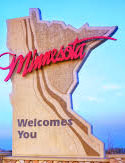Sharing is caring!
 Yesterday, I talked about people. Today it’s time to discuss the economy of the region. We will start in the East at Duluth. The 19th century had brought great prosperity to Duluth. There were many mansions. The best surviving example is the Glensheen Mansion. You can actually visit online at https://glensheen.org/ The wealth came from timber and mining. With the opening of the St. Lawrence Waterway in 1959, the number of ships visiting from foreign countries went from zero to a tremendous number. One of the primary things shipped were corn and wheat. Duluth also had a number of universities with the University of Minnesota, Duluth being the largest. Duluth was an isolated area of some prosperity as was the Mesabi Iron Range. Both were really ghosts of much better times. The Native American reservations were unbelievably poor with people living in tarpaper shacks until the late 1950s when government funds made them richer in things such as housing, but there remain few if any jobs on the reservations outside of administrative positions.
Yesterday, I talked about people. Today it’s time to discuss the economy of the region. We will start in the East at Duluth. The 19th century had brought great prosperity to Duluth. There were many mansions. The best surviving example is the Glensheen Mansion. You can actually visit online at https://glensheen.org/ The wealth came from timber and mining. With the opening of the St. Lawrence Waterway in 1959, the number of ships visiting from foreign countries went from zero to a tremendous number. One of the primary things shipped were corn and wheat. Duluth also had a number of universities with the University of Minnesota, Duluth being the largest. Duluth was an isolated area of some prosperity as was the Mesabi Iron Range. Both were really ghosts of much better times. The Native American reservations were unbelievably poor with people living in tarpaper shacks until the late 1950s when government funds made them richer in things such as housing, but there remain few if any jobs on the reservations outside of administrative positions.
World War II marked a turning point for the area I’m writing about. During the war, most men were in the service and others such as one of my grandparents left the area to work in defense plants. My grandparents on my mother’s side of the family went to the West Coast and worked in shipyards. It was after World War II there was a serious out-migration. Men coming back from the war wanted to improve themselves and find better jobs. At first many of them went to the Twin Cities, Minneapolis and St. Paul. Others went to places they had seen during the war.
There were some that stayed in the area. In Bemidji, there was Bemidji State University. It had started as a college to teach high school and grade school teachers. It provided a base for Bemidji. There were people who still farmed. In most cases, it was little more than subsistence farming. Because of the paper mills and other forest product plants dotted around, there were loggers still making a living doing that. With our many lakes, tourism helped things through the 1950s. However, there still were not enough jobs for people graduating from high school wish to remain in the area. I’ll discuss that tomorrow. I realize this is an extremely short view of the economy of the region. It would take a tremendous tome to detail the economy from World War II until the 1970s.
